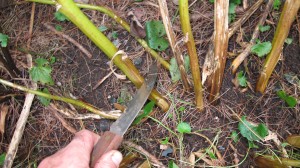Putting the Garden to Bed
When you think of the weeks ahead, do you think that putting the garden to bed means simply raking the leaves and cutting back a few perennial flowers? Or maybe just putting the lawnmower in the garage and the tomato plants on the compost pile? Then you are a minimalist. To have maximum success in the garden, there are many tasks to do between now and the time when snow flies.
If you moved your houseplants plants outside for the summer, begin bringing them in now. Many don’t tolerate even a taste of frost. Wash the leaves on both sides and rinse the surface of the potting mix it’s growing in, too. That will help to wash off aphids and aphid eggs. Inside there are no good bugs to keep the ever-present aphids under control.
If you have an amaryllis that you put outside (either in a pot or in the soil), and want to make it bloom again this winter, bring it inside now. Let it rest un-watered in a dark, dry place for 45 days, then re-pot it (if it was in the ground) and put it on a windowsill. If re-potting, use a fluffy potting mix with lots of peat moss. Garden soil will rot the bulb.
If you grew dahlias and gladiolas, the bulbs will need to be pulled and stored in a paper bag in a cool, dark place until spring. Wait until the tops die back after the first frost – but don’t wait until the ground is near freezing. In the bag with bulbs you can put some slightly damp cedar gerbil bedding. That will help to keep them from drying out over the winter.
Fall is the time to get ahead on next summer’s weeds in garden. Do this by getting rid of all weeds in the flower beds (hopefully before they drop seeds) and in the vegetable garden, which should be clean and weed-free before snow flies. As you harvest vegetables, also weed and clean up. Getting rid of the dead plants in the vegetable garden will minimize the overwintering of things like beetles and fungi.
Now is the time to improve your lawn. Got dead spots, worn out spots? Re-seed in the fall, earlier rather than later. You want to get the new grass plants well established before the soil gets too cold. Germination is quicker now than in the spring – August’s warmth is still held in the soil. Just be sure to keep the soil lightly moist. I usually cover grass seed with a light layer of mulch hay or straw to provide shade on the hot Indian summer days.
Fall is also a good time to give your lawn a dose of limestone and organic fertilizer. It will slowly be incorporated into the soil over the months ahead. You can have the lawn soil tested by your Cooperative Extension, or just Google “soil testing” and learn how to take a sample and where to send it. Most lawns will benefit from some compost. Just fling it with a shovel, and spread it around with the back side of a lawn rake (with the tines in the air).
At some point before winter, prepare your beds for planting next year’s vegetable garden. That will allow you to plant early crops like spinach and peas much earlier if we have, as we usually do, a wet spring. It’s never good to work in wet soil. And rototilling should be avoided until the soil dries out (though I personally don’t till anymore). Later, after I’ve raked up my leaves, I’ll spread them over my mounded, raised beds. Raised beds dry out and warm up faster than beds that are flat.
Flower beds get better each year. Or they do if you pay attention to your soil by adding organic matter. If you have mulch on your beds, rake it off and spread some compost or sheep manure over the surface. Then scratch it in a little and put back the mulch. Sheep, goat, llama and rabbit manure is all relatively free of weed seeds and adds organic matter and minerals to the soil. A top dressing of organic fertilizer will improve the soil, too. Unlike many chemical fertilizers, most components of organic fertilizer are not water soluble.
You can divide big clumps of purple cone flowers, black-eyed Susan, phlox, asters, hostas, iris, daylilies and most other perennials either now or in the spring. The more you do now, the less you will have to do in spring. Moving or dividing peonies is generally recommended for the fall, after the plants have begun to go dormant.
There’s plenty more to do before the snow flies, and I will nag you again later to do more including cleaning up your berry patch and cutting back this years’ fruiting canes, pruning hardwood trees and deciduous shrubs after leaf drop, planting bulbs and more. Meanwhile, enjoy the crisp days of fall and find time to watch the butterflies feeding on our last flowers of summer.
Henry Homeyer is the author of 4 gardening books and a Wobar, a fantasy-adventure book for children. His Web site is www.Gardening-guy.com.




